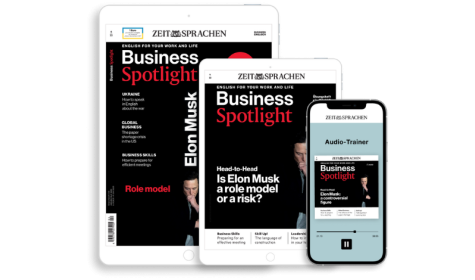Starten Sie den Audio-Text
Mit dem Audio-Player können Sie sich den Text anhören. Darunter finden Sie das Transkript.
We’ve all sat through a presentation wishing we were somewhere else. As the presenter drone on about sth.über etw. langatmig redendrones on about what feels like the 100th highly detailed PowerPoint slidehier: Folieslide, we think of all the work that’s still waiting for us. It’s not that the subject is uninteresting — it’s just that the presenter’s approachHerangehensweiseapproach is boring. What can this poor presenter do to make their presentation more interesting? They need the seven keys to powerful presentations.
1. Proper preparation
Your purposeZiel(setzung)purpose is not to impress your audiencePublikum, Zuhörer(innen)audience with your knowledge but to give them a feel for your ideas, get them interested in learning more, and to engage sb.jmdn. einbindenengage and excite them. Identify one specific idea you want your audience to remember and organize your talk around it. Be ruthlessschonungslosruthless and discard sth.etw. verwerfen, streichendiscard anything irrelevant.
Preparation takes time, especially in a second language. Expect to take ten minutes preparing for every one minute of presenting. Then, you should practise giving your presentation, in front of a mirror or on video, for example.
2. Simple structure
A clear, simple structure helps you to get your ideas get sth. acrossetw. vermitteln, rüberbringenacross. First, grab sth.etw. packen; hier: auf sich ziehengrab your audience’s attention with a memorableeinprägsammemorable opening. Then, tell them how they’ll benefit from listening to you. Your central message should have no more than three to five main points. Use some practical examples, as they show your ideas in action. If time is short, leave out the theory but not the example! End with a memorable closing.
3. Opening and closing
Your first few sentences should focus attention on you and your topicThematopic, and make your audience want to listen. You might start with a rhetorical question, for example, followed by the aim of the presentation and your benefit promise:
“How will AI (artificial intelligence)KI (künstliche Intelligenz)AI affect sth.sich auf etw. auswirkenaffect our business model in the next five years? The next 30 minutes will give you an overview of the challenges our IT team will face in the future. You’ll then hear clear proposals for our strategy to meet those challenges.”
Make your opening snappy (ifml.)schwungvoll; hier: kurzsnappy and to the point. Keep the audience’s question in mind — “What’s in it for me?Was habe ich davon?What’s in it for me?”
Ask if there are any questions before you close — so that you have the last word. Make it clear that you’re coming to the end. summarize sth.etw. zusammenfassenSummarize your key points and end with that big idea you want people to remember:
“If you remember nothing else, remember this — AI is coming, whether we like it or not. We have to learn to live with it and manage it.”
4. Know your audience
You need to assess sth.etw. einschätzenassess how much your audience knows about your topic, because this affects your level of detail. What’s their motivation for being there? What’s their professional background — this affects your examples.
Involve the audience. Use rhetorical questions to get them thinking; open questions when you want a response; and with a show of handsHandhebenshow of hands, you can check their experience. The more your audience feels part of the presentation, the better they’ll take your ideas take sth. on boardhier: etw. annehmenon board.
5. Visualization
The most important visual aidHilfe, Hilfsmittelaid is your own body language. Use your hands for emphasisBetonung, Nachdruckemphasis. Change your position to show a change of subject. Keep eye contact with the whole audience. And don’t let PowerPoint take over. blank sth.etw. deaktivieren, ausblendenBlank the screen when you want to make a key point, and when you make your summary and key final point.
Make use of various visual tools — not just PowerPoint. If possible, set up a modern whiteboard or flip chart. Sometimes, a good story is more visually powerful than a picture.
6. International English
Use short sentences and simple vocabulary, rather thananstattrather than complex language, and emphasize key words with your voice. Keep in mind that some, or possibly all, of the audience will also be second-language speakers. Make it easy for them to understand you.
7. Be creative
Surprise your audience with something different. I once saw a presenter start by singing “Money, Money, Money” by ABBA — it was also the title of his talkhier: Vortragtalk. Another began by sitting in the audience chatting to key decision-makers. And a third included a quiz in her presentation, complete with small prizes. Your ideas are more likely to be remembered if you do something memorable.
Finally, remember this: none of this will help unless you support your presentation with energy, enthusiasm and excitement. If you don’t show enthusiasm for your ideas, why would anyone else be enthusiastic? If you can create a feeling of excitement, you will have succeeded in making a powerful presentation.
Neugierig auf mehr?
Dann nutzen Sie die Möglichkeit und stellen Sie sich Ihr optimales Abo ganz nach Ihren Wünschen zusammen.



